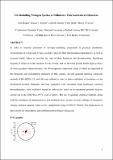| dc.contributor.author | Bugler, John | |
| dc.contributor.author | Somers, Kieran P. | |
| dc.contributor.author | Simmie, John M. | |
| dc.contributor.author | Guthe, Felix | |
| dc.contributor.author | Curran, Henry J. | |
| dc.date.accessioned | 2017-10-05T11:04:59Z | |
| dc.date.available | 2017-10-05T11:04:59Z | |
| dc.date.issued | 2016-08-22 | |
| dc.identifier.citation | Bugler, John, Somers, Kieran P., Simmie, John M., Güthe, Felix, & Curran, Henry J. (2016). Modeling Nitrogen Species as Pollutants: Thermochemical Influences. The Journal of Physical Chemistry A, 120(36), 7192-7197. doi: 10.1021/acs.jpca.6b05723 | en_IE |
| dc.identifier.issn | 1089-5639 | |
| dc.identifier.uri | http://hdl.handle.net/10379/6864 | |
| dc.description.abstract | To simulate emissions of nitrogen-containing compounds in practical combustion environments, it is necessary to have accurate values for their thermochemical parameters, as well as accurate kinetic values to describe the rates of their formation and decomposition. Significant disparity is observed in the literature for the former, and we therefore present herein high-accuracy ab initio gas phase thermochemistry for 60 nitrogenous compounds, many of which are important in the formation and consumption chemistry of NOx species. Several quantum chemical composite methods (CBS-APNO, G3, and G4) were utilized to derive enthalpies of formation-via the atomization method. Entropies and heat capacities were calculated from traditional statistical thermodynamics, with oscillators treated as anharmonic based on ro-vibrational property analyses carried out at the B3LYP/cc-pVTZ level of theory. The use of quantum chemical methods, along with the treatments of anharmonicities and hindered rotors, ensures accurate enthalpy of formation, entropy, and heat capacity values across the temperature range 298.15-3000 K. The implications of these results for atmospheric and combustion modeling are discussed. | en_IE |
| dc.description.sponsorship | The authors acknowledge the support of the Irish Research
Council and GE Power Ltd. in funding this project under grant
number EPSPG/2012/380. We also acknowledge the provision
of computational resources from the Irish Centre for High-End
Computing, ICHEC, under project number ngche026c. | en_IE |
| dc.format | application/pdf | en_IE |
| dc.language.iso | en | en_IE |
| dc.publisher | American Chemical Society | en_IE |
| dc.relation.ispartof | Journal Of Physical Chemistry A | en |
| dc.rights | Attribution-NonCommercial-NoDerivs 3.0 Ireland | |
| dc.rights.uri | https://creativecommons.org/licenses/by-nc-nd/3.0/ie/ | |
| dc.subject | COMPOUND METHODS CBS-QB3 | en_IE |
| dc.subject | FORMATION ENTHALPIES | en_IE |
| dc.subject | HIGH-PRESSURE | en_IE |
| dc.subject | CBS-APNO | en_IE |
| dc.subject | TEMPERATURE OXIDATION | en_IE |
| dc.subject | NO FORMATION | en_IE |
| dc.subject | COMBUSTION | en_IE |
| dc.subject | CHEMISTRY | en_IE |
| dc.subject | G3 | en_IE |
| dc.subject | AMMONIA | en_IE |
| dc.subject | Chemistry | en_IE |
| dc.title | Modeling nitrogen species as pollutants: thermochemical influences | en_IE |
| dc.type | Article | en_IE |
| dc.date.updated | 2017-10-03T07:50:05Z | |
| dc.identifier.doi | 10.1021/acs.jpca.6b05723 | |
| dc.local.publishedsource | http://dx.doi.org/10.1021/acs.jpca.6b05723 | en_IE |
| dc.description.peer-reviewed | peer-reviewed | |
| dc.contributor.funder | |~| | |
| dc.internal.rssid | 12049677 | |
| dc.local.contact | Henry Curran, Dept Of Chemistry, Room 215, Arts/Science Building, Nui Galway. 3856 Email: henry.curran@nuigalway.ie | |
| dc.local.copyrightchecked | No | |
| dc.local.version | ACCEPTED | |
| nui.item.downloads | 479 | |


